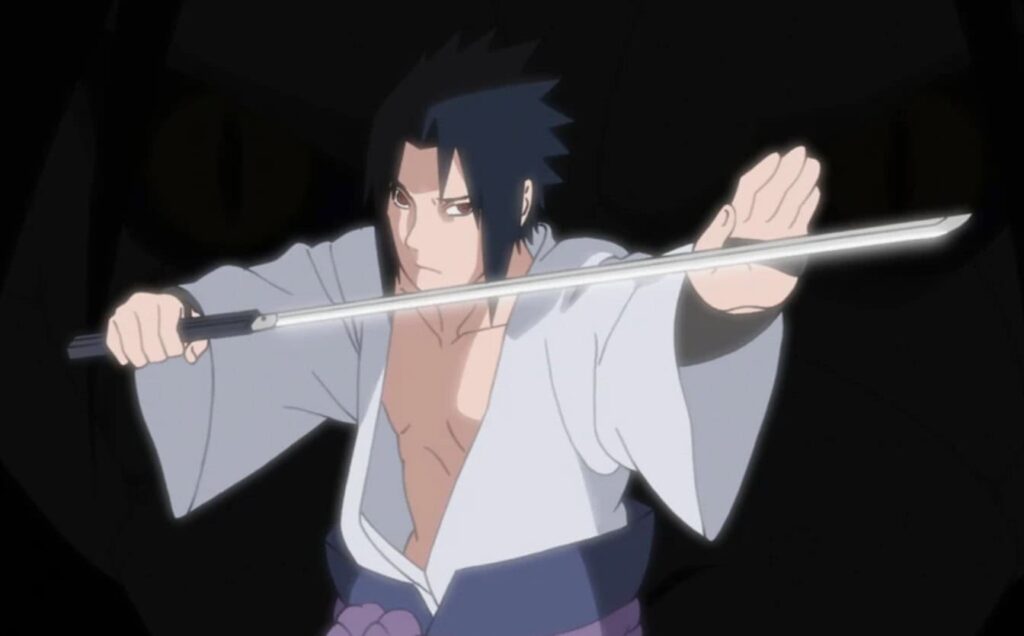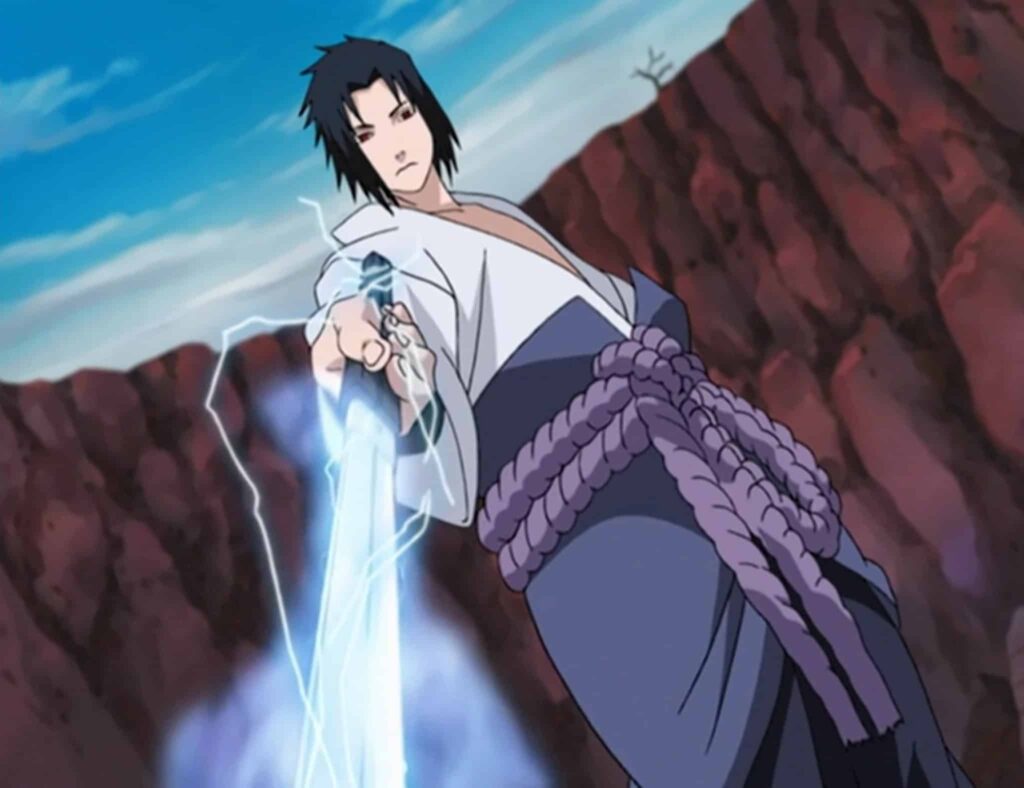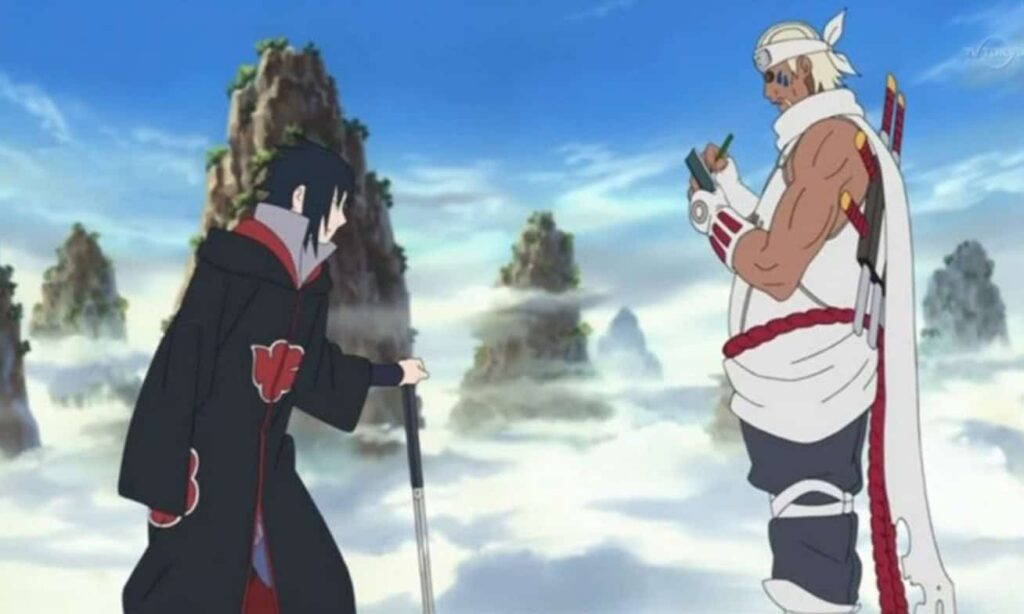The Lore Behind Sasuke’s Chokuto
TLDR: Sasuke’s original chokuto, a significant weapon in his journey, was ultimately lost in battle after being wielded by both Itachi during the Fourth Shinobi World War and Madara against Sasuke, leading to the acquisition of a new sword that continues to play a vital role in his fighting style.
You know, I’ve always been fascinated by the weapons in Naruto, but there’s something special about Sasuke’s chokuto that just grabs my attention. It’s not just a sword; it’s a piece of his journey, his growth, and his power. From the moment Orochimaru handed it to him, I knew this blade was going to be a game-changer. I mean, a straight sword in a world of kunai and shuriken? That’s bold. And the fact that it’s based on the legendary Kusanagi? Man, that’s just cool on a whole other level. I can’t wait to dive into the story behind this awesome weapon and share what I’ve learned about its lore, abilities, and the role it played in shaping one of my favorite characters.
The Origin of Sasuke’s Chokuto
Sasuke’s chokuto, a straight-edged sword that became his signature weapon, has a fascinating origin tied to his time with Orochimaru. During Sasuke’s intense training under the Sannin, Orochimaru presented him with this blade, recognizing the young Uchiha’s potential for kenjutsu. This gift wasn’t just any ordinary sword; it was crafted as a replica of the legendary Kusanagi sword, a weapon steeped in Japanese mythology and wielded by Orochimaru himself.
The decision to give Sasuke a replica of the Kusanagi was likely twofold. Firstly, it served as a tool to further Sasuke’s training, allowing him to develop his swordsmanship skills. Secondly, it may have been part of Orochimaru’s plan to groom Sasuke as his future vessel, equipping him with a weapon that mirrored his own.
However, it’s crucial to understand the differences between Sasuke’s chokuto and Orochimaru’s Kusanagi:
- Origin: Orochimaru’s Kusanagi is the actual legendary sword from Japanese mythology, while Sasuke’s is a replica.
- Abilities: The original Kusanagi possessed numerous supernatural abilities, including:
- Extending and shortening at will
- Telekinetic control
- Transformation into a small serpent
- Ability to cut through almost anything
In contrast, Sasuke’s chokuto, while exceptionally sharp and durable, lacked these inherent magical properties.
| Characteristic | Orochimaru’s Kusanagi | Sasuke’s Chokuto |
| Origin | Legendary artifact | Crafted replica |
| Special Abilities | Multiple supernatural powers | None inherent |
| Storage | Inside Orochimaru’s body | External sheath |
The Legendary Kusanagi: Inspiration for Sasuke’s Chokuto
The legendary Kusanagi sword, which inspired Sasuke’s chokuto, has a rich history deeply rooted in Japanese mythology. The tale of its origin is a captivating story of heroism and divine intervention, centering around the Shinto god Susanoo and the fearsome Yamata no Orochi.
According to the ancient chronicle Kojiki, Susanoo encountered a distressed family in Izumo Province who were being terrorized by an eight-headed serpent called Yamata no Orochi. The serpent had already devoured seven of their daughters and was after the eighth, Kushinada-hime. Susanoo, in a display of cunning and bravery, devised a plan to defeat the monster.
The god prepared eight vats of sake, placing them behind a fence with eight gates. When Yamata no Orochi arrived, each of its heads drank from a vat, becoming intoxicated. Seizing this opportunity, Susanoo struck, decapitating each of the serpent’s heads. As he sliced through the creature’s tail, he made an astonishing discovery – a magnificent sword was hidden within.
This sword, initially named Ame-no-Murakumo-no-Tsurugi (Sword of the Gathering Clouds of Heaven), would later become known as Kusanagi-no-Tsurugi. The blade’s renaming occurred generations later when it was wielded by Prince Yamato Takeru, who used it to cut through burning grass during an ambush, hence earning it the moniker “Grass-Cutting Sword”.
Kusanagi’s significance extends beyond its mythical origins. It is revered as one of Japan’s Three Sacred Treasures, alongside the Yata no Kagami mirror and the Yasakani no Magatama jewel. These imperial regalia symbolize the emperor’s divine right to rule and are central to Japan’s imperial succession rituals.
Key aspects of Kusanagi’s legendary status:
- Divine origin
- Supernatural powers (e.g., controlling wind)
- Symbol of imperial authority
- Object of numerous quests and searches throughout history
| Attribute | Kusanagi | Sasuke’s Chokuto |
| Origin | Mythical (from Orochi’s tail) | Crafted by Orochimaru |
| Powers | Supernatural abilities | Channels chakra |
| Status | Sacred imperial treasure | Personal weapon |
As an enthusiast of Japanese mythology, I find the parallels between Kusanagi and Sasuke’s chokuto fascinating. The way the creators of Naruto drew inspiration from this ancient legend to craft Sasuke’s signature weapon adds depth to his character. It’s intriguing to consider how the mythical properties of Kusanagi might have influenced the portrayal of Sasuke’s lightning-based techniques with his chokuto.
Physical Properties of Sasuke’s Chokuto
Sasuke’s chokuto is a distinctive weapon characterized by its straight, single-edged blade. Unlike the more common curved katana, this sword maintains a linear profile from hilt to tip. The blade’s length is approximately 69 cm (27 inches), with a width of 2.9 cm (1.1 inches) and a thickness of 0.5 cm (0.2 inches). This design allows for powerful thrusting attacks while still maintaining the ability to deliver effective slashing strikes.
When compared to traditional katana, Sasuke’s chokuto stands out in several ways:
- Blade shape: Straight vs. curved
- Length: Generally shorter than a full-length katana
- Intended use: Versatile for both stabbing and slicing, whereas katana excel at slashing
The durability and sharpness of Sasuke’s chokuto are remarkable. Crafted from high carbon steel, the blade is capable of withstanding strong impacts, making it a functional, battle-ready weapon. Its mono-tempered construction contributes to its overall strength and resilience. The blade’s sharpness is maintained through careful forging and tempering processes, allowing it to retain its edge even after intense combat.
| Feature | Sasuke’s Chokuto | Traditional Katana |
| Blade Shape | Straight | Curved |
| Edge | Single-edged | Single-edged |
| Primary Use | Versatile (thrust/slash) | Primarily slashing |
| Typical Length | 69 cm (blade) | 60-80 cm (blade) |
Magical Abilities of Sasuke’s Chokuto
Sasuke’s chokuto, while not inherently magical, possesses remarkable abilities when infused with his chakra. The most notable of these is its capacity to channel lightning chakra, a technique that dramatically enhances the sword’s combat effectiveness. When Sasuke flows his lightning-nature chakra through the blade, it becomes a conduit for his elemental power, transforming from a simple sword into a formidable weapon capable of cutting through almost any material.
This chakra infusion significantly increases the chokuto’s cutting power and range. The lightning chakra extends beyond the physical length of the blade, creating an invisible, razor-sharp edge that can slice through targets at a distance. This extended reach allows Sasuke to strike opponents who believe they’re safely out of range, giving him a considerable advantage in close-quarters combat.
Another intriguing aspect of the chakra-infused chokuto is its ability to numb opponents when struck. The lightning chakra coursing through the blade can disrupt an enemy’s nervous system upon contact, causing temporary paralysis or numbness in the affected area. This effect can be particularly devastating in prolonged battles, as it gradually reduces an opponent’s mobility and reaction time.
Key abilities of Sasuke’s chakra-infused chokuto:
- Lightning chakra channeling
- Enhanced cutting power
- Extended attack range
- Numbing effect on opponents
- Increased durability of the blade
| Ability | Without Chakra | With Lightning Chakra |
| Cutting Power | Standard | Greatly enhanced |
| Range | Limited to blade length | Extended beyond physical blade |
| Special Effect | None | Numbing/paralyzing effect |
As a fan of unique weapon systems in anime, I find the concept of Sasuke’s chokuto fascinating. The way it seamlessly integrates with his lightning-style jutsu showcases a brilliant fusion of traditional swordsmanship and ninjutsu. It’s particularly intriguing to consider how this weapon complements Sasuke’s fighting style, allowing him to capitalize on both his kenjutsu skills and his affinity for lightning-based techniques.
The Chokuto’s Role in Sasuke’s Fighting Style
Sasuke’s chokuto plays a pivotal role in his fighting style, seamlessly integrating with his kenjutsu skills and complementing his other ninja techniques. After receiving training in kenjutsu from Orochimaru, Sasuke incorporated the chokuto as a primary weapon in his arsenal, enhancing his close-range combat abilities. The straight, slender blade allows for swift and precise strikes, perfectly suiting Sasuke’s agile fighting style.
The chokuto’s versatility shines in its combination with Sasuke’s wire string and shuriken techniques. Sasuke often uses the sword in tandem with wire strings to create complex traps or to manipulate the trajectory of his attacks. He can also summon countless shuriken of various sizes using special seals on his wrists, which he then combines with the chokuto for devastating combination attacks. This integration of weaponry showcases Sasuke’s tactical prowess and ability to overwhelm opponents with multi-layered assaults.
Sasuke’s Sharingan abilities further enhance the effectiveness of his chokuto techniques. The Sharingan’s predictive capabilities and enhanced perception allow Sasuke to wield the blade with unparalleled precision and timing. This synergy is particularly evident in his ability to counter enemy attacks and exploit openings that would be imperceptible to the average shinobi.
Key aspects of the chokuto’s role in Sasuke’s fighting style:
- Primary close-range weapon
- Conduit for lightning-based techniques
- Integrated with wire string and shuriken tactics
- Enhanced by Sharingan perception
- Versatile tool for offense and defense
| Technique | Description | Synergy with Chokuto |
| Kenjutsu | Sword fighting skills | Direct application |
| Wire String Manipulation | Control of thin, sharp wires | Used for traps and misdirection |
| Shuriken Jutsu | Throwing star techniques | Combined for multi-angle attacks |
| Sharingan | Visual prowess and prediction | Enhances precision and timing |
As someone fascinated by the intricacies of ninja combat, I find the way Sasuke integrates his chokuto into his overall fighting style particularly impressive. The seamless blending of traditional swordsmanship with ninjutsu and his unique Sharingan abilities creates a combat style that is both visually striking and tactically sophisticated.
Notable Battles Featuring Sasuke’s Chokuto
Sasuke’s chokuto has been a pivotal element in many of his most significant battles, showcasing its effectiveness against formidable opponents. One of the most notable instances was during Sasuke’s confrontation with Deidara, where the sword played a crucial role in countering the Akatsuki member’s explosive clay techniques. Sasuke skillfully used his chokuto, infused with Chidori, to neutralize Deidara’s bombs and create openings for his attacks.
Another significant battle that highlighted the chokuto’s importance was Sasuke’s fight against his brother, Itachi. Throughout this emotionally charged and tactically complex battle, Sasuke repeatedly used his sword to enhance his lightning-based techniques and engage in close-quarters combat. The chokuto’s durability was put to the test as it clashed with Itachi’s own formidable abilities.
The sword’s effectiveness against powerful opponents was further demonstrated in Sasuke’s encounters with various Kage-level shinobi. For instance, during the Five Kage Summit arc, Sasuke utilized his chokuto in combination with his newly awakened Mangekyō Sharingan abilities, proving its versatility in high-stakes combat situations.
Notable battles featuring Sasuke’s chokuto:
- Sasuke vs. Deidara
- Sasuke vs. Itachi
- Sasuke vs. the Five Kage
- Sasuke vs. Danzo
- Sasuke vs. Killer Bee
| Opponent | Key Sword Technique Used |
| Deidara | Chidori-infused slashes |
| Itachi | Lightning manipulation |
| Killer Bee | Sword of Kusanagi: Chidori Katana |
As an enthusiast of weapon-based combat in anime, I find the evolution of Sasuke’s swordsmanship throughout these battles particularly captivating. The way he adapts his use of the chokuto to counter diverse enemy abilities showcases not only the sword’s versatility but also Sasuke’s growth as a strategist and fighter.
The Fate of Sasuke’s Original Chokuto
The fate of Sasuke’s original chokuto took an unexpected turn during the Fourth Shinobi World War. In a surprising twist, the sword found its way into the hands of Itachi Uchiha, who had been reanimated by the Edo Tensei jutsu. Itachi wielded the chokuto with remarkable skill, using it in conjunction with his own abilities during his confrontations with Kabuto Yakushi and later, in his final moments with Sasuke.
Following Itachi’s second passing, the chokuto’s journey continued as it fell into the possession of Madara Uchiha. In a cruel irony, Madara turned the blade against its original owner, using Sasuke’s own weapon in their fierce battle. This moment served as a stark reminder of Madara’s cunning and his ability to exploit any advantage in combat, even using his opponent’s tools against them.
The original chokuto met its ultimate fate during the intense battles of the war. Amidst the chaos and destruction of high-level shinobi combat, the sword was lost or destroyed, marking the end of its significant role in Sasuke’s journey. The loss of this weapon, which had been with Sasuke through so many crucial moments, symbolized a turning point in his character development and fighting style.
Key events in the fate of Sasuke’s original chokuto:
- Acquisition by Itachi during his reanimation
- Use by Madara against Sasuke
- Loss or destruction in battle
- Symbolic representation of Sasuke’s evolution as a shinobi
| Wielder | Significance of Use |
| Itachi | Unexpected ally, emotional impact |
| Madara | Ironic twist, symbol of power dynamics |
| Sasuke | Original owner, loss represents character growth |
As a fan of symbolic storytelling in anime, I find the journey of Sasuke’s chokuto particularly compelling. The way the sword changes hands and ultimately meets its end mirrors Sasuke’s own path of growth and transformation throughout the series.
Sasuke’s New Sword: A Successor to the Chokuto
After the Fourth Great Ninja War, Sasuke acquired a new sword to replace his lost chokuto. This new blade, while similar in appearance to his original weapon, represents a continuation of Sasuke’s journey and evolution as a shinobi. According to the eighth supplementary guidebook of Naruto, called Zai no Sho, this new sword is also referred to as the Kusanagi sword, maintaining a connection to its predecessor.
The new sword, while visually reminiscent of the original chokuto, possesses some notable differences. It appears to be more durable and possibly even more powerful than its predecessor. This is evidenced by Sasuke’s ability to use it effectively against formidable opponents such as the Otsutsuki clan members. In one instance, Sasuke managed to cut Kinshiki’s horn with ease using this new blade, showcasing its impressive cutting power.
Swordsmanship continues to play a crucial role in Sasuke’s fighting style, even with his new weapon. The integration of the sword with his ninjutsu and dojutsu abilities remains a cornerstone of his combat technique. Sasuke’s proficiency with the blade allows him to seamlessly incorporate it into his diverse array of skills, making him an even more versatile and dangerous opponent.
Key differences between the new sword and the original chokuto:
- Enhanced durability
- Potentially greater cutting power
- Improved synergy with Sasuke’s evolved abilities
- Ability to match against high-level threats like Isshiki’s rods
Final Thoughts
Looking back at everything we’ve covered about Sasuke’s chokuto, I’m even more impressed by how much thought went into this weapon. It’s not just a cool-looking sword; it’s a vital part of Sasuke’s character development and fighting style. I love how it evolved with him, from his training with Orochimaru to his battles in the Fourth Shinobi World War. Even though he lost the original chokuto, the fact that he got a new sword afterward shows just how important swordsmanship is to him. In my opinion, Sasuke’s chokuto is more than just a weapon – it’s a symbol of his journey and his incredible growth as a shinobi.



